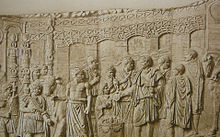Trajan's Bridge

Trajan's Bridge (Romanian: Podul lui Traian; [Трајанов мост, Trajanov Most] Error: {{Lang-xx}}: text has italic markup (help)) or Bridge of Apollodorus over the Danube was a Roman segmental arch bridge, the first to be built over the lower Danube. For more than a thousand years, it was the longest arch bridge in the world to have been built, in terms of both total and span length.[1] The bridge was constructed by the Greek architect Apollodorus of Damascus for the deployment of Roman troops in the war against Dacia, in 105 AD.
Description

The bridge was situated East from the Iron Gates, nearby the present-day cities of Drobeta-Turnu Severin (Romania) and Kladovo (Serbia). Its construction was ordered by Emperor Trajan as a supply route for the Roman legions fighting in Dacia.
The structure was 1,135 m in length (the Danube is 800 meters-wide in that area), 15 m in width, and reached 19 m in height (measured from the river's surface). At each end was situated a Roman castrum, each of them built around an entrance (crossing was possible only by walking through the camp).
Its engineer, Apollodorus of Damascus, used wooden arches set on twenty masonry pillars (made with bricks, mortar and pozzolana cement) that spanned 38 m each.[2] Nevertheless, it was built over an unusually short period of time (between 103 and 105) — one possible explanation is that the river was diverted during the bridge's construction.
Tabula Traiana

A Roman memorial plaque ("Tabula Traiana"), 4 meters in width and 1.75 meters in height, commemorating the completion of Trajan's military road is located on the Serbian side facing Romania near Ogradina. It reads:
- IMP. CAESAR. DIVI. NERVAE. F
NERVA TRAIANVS. AVG. GERM
PONTIF MAXIMUS TRIB POT IIII
PATER PATRIAE COS III
MONTIBVUS EXCISI(s) ANCO(ni)BVS
SVBLAT(i)S VIA(m) F(ecit)
The text was interpreted by Otto Benndorf to mean:
- Emperor Caesar son of the divine Nerva, Nerva Trajan, the Augustus, Germanicus, Pontifex Maximus, invested for the fourth time as Tribune, Father of the Fatherland, Consul for the third time, excavating mountain rocks and using wood beams has made this road.
Tabula Traiana was declared Monument of Culture of Exceptional Importance in 1979, and it is protected by Republic of Serbia.
Destruction/erosion and remains

The bridge was destroyed by Aurelian, after the Roman Empire withdrew its troops from Dacia.[citation needed]
The twenty pillars could still be seen in the year 1856, when the level of the Danube hit a record low.
In 1906, the International Commission of the Danube decided to destroy two of the pillars that were obstructing navigation.
In 1932, there were 16 remaining pillars underwater, but in 1982 only 12 were mapped by archeologists — the other four had probably been swept away by water. Only the entrance pillars are nowadays visible on either bank of the Danube.[3]
In 1979, Trajan's Bridge was added to the Monument of Culture of Exceptional Importance, and in 1983 on Archaeological Sites of Exceptional Importance list, and by that it is protected by Republic of Serbia.
See also

References
- ^ In terms of overall length, the bridge seems to have been surpassed by another Roman bridge across the Danube, Constantine's Bridge, a little-known structure whose length is given with 2437 m (Tudor 1974b, p. 139; Galliazzo 1994, p. 319).
- ^ Troyano, Leonardo Fernández, "Bridge Engineering - A Global Perspective", Thomas Telford Publishing, 2003
- ^ Romans Rise from the Waters
Further reading
- Bancila, Radu; Teodorescu, Dragos (1998), "Die römischen Brücken am unteren Lauf der Donau", in Zilch, K.; Albrecht, G.; Swaczyna, A.; Weber, J. (eds.), Entwurf, Bau und Unterhaltung von Brücken im Donauraum, 3. Internationale Donaubrückenkonferenz, 29–30 October, Regensburg, pp. 401–409
{{citation}}: CS1 maint: location missing publisher (link) - Galliazzo, Vittorio (1994), I ponti romani. Catalogo generale, vol. Vol. 2, Treviso: Edizioni Canova, pp. 320–324 (No. 646), ISBN 88-85066-66-6
{{citation}}:|volume=has extra text (help) - Griggs, Francis E. (2007), "Trajan's Bridge: The World's First Long-Span Wooden Bridge", Civil Engineering Practice, 22 (1): 19–50, ISSN 0886-9685
- Gušić, Sima (1996), "Traian's Bridge. A Contribution towards its Reconstruction", in Petrović, Petar (ed.), Roman Limes on the Middle and Lower Danube, Cahiers des Portes de Fer, vol. 2, Belgrade, pp. 259–261
{{citation}}: CS1 maint: location missing publisher (link) - O’Connor, Colin (1993), Roman Bridges, Cambridge University Press, pp. 142–145 (No. T13), 171, ISBN 0-521-39326-4
- Serban, Marko (2009), "Trajan's Bridge over the Danube", The International Journal of Nautical Archaeology, 38 (2): 331–342, doi:10.1111/j.1095-9270.2008.00216.x
- Tudor, D. (1974a), "Le pont de Trajan à Drobeta-Turnu Severin", Les ponts romains du Bas-Danube, Bibliotheca Historica Romaniae Études, vol. 51, Bucharest: Editura Academiei Republicii Socialiste România, pp. 47–134
- Tudor, D. (1974b), "Le pont de Constantin le Grand à Celei", Les ponts romains du Bas-Danube, Bibliotheca Historica Romaniae Études, vol. 51, Bucharest: Editura Academiei Republicii Socialiste România, pp. 135–166
- Ulrich, Roger B. (2007), Roman Woodworking, Yale University Press, pp. 104–107, ISBN 0-300-10341-7
- Vučković, Dejan; Mihajlović, Dragan; Karović, Gordana (2007), "Trajan's Bridge on the Danube. The Current Results of Underwater Archaeological Research", Istros (14): 119–130
External links
- Bridge of Apollodorus over the Danube at Structurae
- Romans Rise from the Waters – Excavations
- Traianus – Technical investigation of Roman public works
- Trajan's bridge near Kladovo (language?)
- Bridges over the Danube
- Bridges in Romania
- Bridges in Serbia
- Roman segmental arch bridges
- Deck arch bridges
- 2nd-century bridges
- Demolished bridges
- Dacia
- Drobeta-Turnu Severin
- Monument of Culture of Exceptional Importance
- Serbian architecture
- Tourism in Serbia
- History of Serbia
- Timočka Krajina
- Archaeological sites in Serbia
- Archaeological Sites of Exceptional Importance

